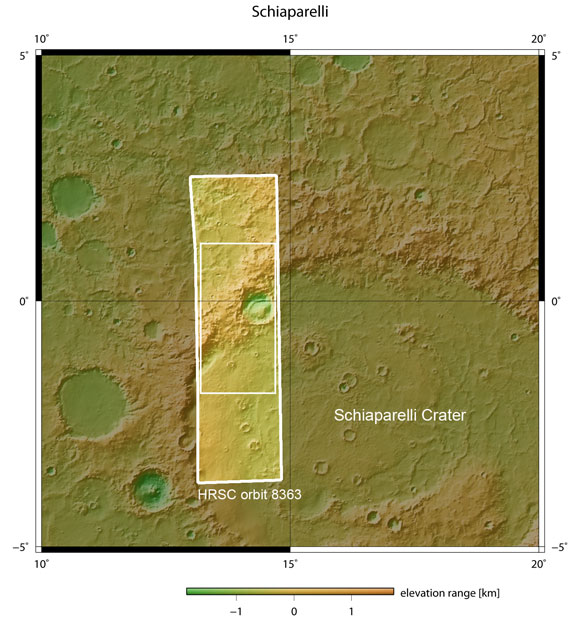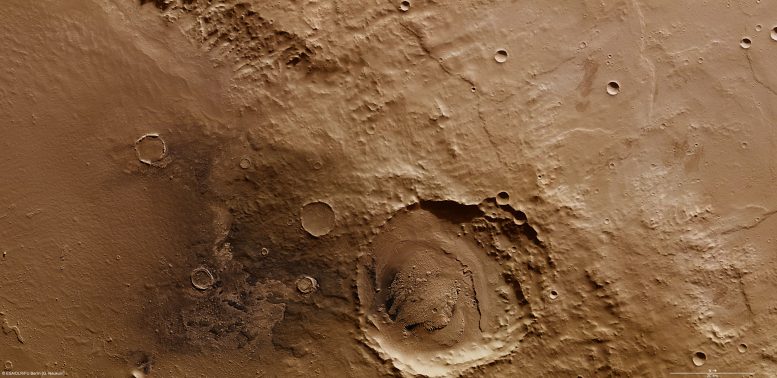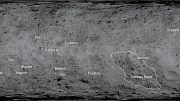This image from ESA’s Mars Express features the small crater embedded in the northwestern rim of the Schiaparelli impact basin. All around is evidence for past water and the great Martian winds that periodically blow.
A 42 km (26 mi)-wide impact crater and numerous smaller craters straddle the northwestern rim of the 460 km (290 mi)-diameter Schiaparelli basin in this image taken by ESA’s Mars Express on 15 July 2010.
The large basin is named for Italian astronomer Giovanni Schiaparelli (1835–1910). The entry, descent, and landing demonstrator module of the joint ESA–Roscosmos ExoMars 2016 mission also honors the astronomer with the name Schiaparelli.
Giovanni Schiaparelli is famous for observing straight-line features on Mars that he called ‘canali’. This term was mistakenly translated into English as ‘canal’ instead of ‘channel’, conjuring up images of vast irrigation networks constructed by intelligent beings.
We now know that Schiaparelli’s canali were illusions created by the comparatively poor telescopes of the time and that there are no water-filled channels on Mars today – but there is plenty of evidence that water was once present in Mars’ past. The Schiaparelli basin may be one such location: layers in its walls and deposits on its floor suggest it once hosted a lake. The scene shown here has also been modified by lava flows and wind erosion.
Meanwhile, the ‘other’ Schiaparelli, that of the ExoMars 2016 mission, is getting ready – along with the Trace Gas Orbiter – to leave Europe for its launch site in Kazakhstan. They are due for launch on a Russian Proton rocket in March 2016, arriving at the Red Planet in October.
While Schiaparelli will demonstrate technologies for Europe to land on Mars, the orbiter will take a detailed inventory of Mars’ trace gases. Although present in the atmosphere only in very small quantities, these gases, including methane, imply a current source and therefore could be linked to present-day geological or biological activity.

Schiaparelli is a large impact basin about 460 km (290 mi) across, located in the eastern Terra Meridiani region of the planet’s equator. This image is centered on the equator of Mars, at a longitude of about 14°E. The new Mars Express image shows just a small part of the basin’s northwestern rim and a smaller 42-km-diameter crater in its rim.
More Information
Schiaparelli is a large impact basin about 460 km (290 mi) in diameter located in the eastern Terra Meridiani region of the equator of Mars. The center of the basin lies at about 3°S/17°E and is named after the Italian astronomer Giovanni Schiaparelli (1835–1910). Although he also studied Mercury and Venus, he is best known for his observations of the Red Planet.
Schiaparelli in context
During the ‘Great Opposition’ of 1877, when Mars passed close to Earth, Schiaparelli mapped the planet, perceiving a number of straight dark lines across the red surface. He assumed that these were natural water-filled channels and used the equivalent Italian word, ‘canali’.
However, other astronomers thought he meant canals, meaning artificial irrigation and transportation routes, which led to a few astronomers, and a large number of the general public, believing that they had been created by intelligent Martians.
Now we know that Schiaparelli’s ‘canali’ were illusions created by the comparatively poor telescopes of the time and there are no water-filled channels on Mars today. Nevertheless, there is evidence in this new picture that water was once present in this region of the planet, perhaps in the form of a lake.










Also known as “Entrance Crater” and, beside it, “Entrance Ramp” into Schiaparelli..